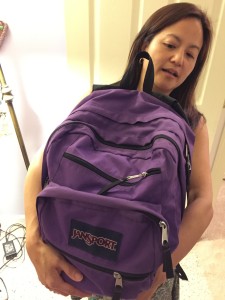Although we see in the news that ebooks are replacing textbooks, our kid’s backpacks look heavier than ever. Returning is physical therapist Dr. Deborah Stack with backpack pointers. -Drs. Lai and Kardos
With the return to school, we wanted to remind you of some healthy backpack tips including adjusting your backpack. I recall the first day of school one year when the “first day of school” photo showed my not-quite-100-pound child bending in half under the weight of a backpack, trombone, lunchbox and art portfolio. I quietly decreed that it would not happen again. To make sure it does not happen at your house either, consider a few suggestions to keep your children healthy:
- A traditional backpack with two shoulder straps distributes the weight more evenly than a pack or messenger bag with a single strap.
- Look for wide, padded straps. Narrow straps can dig in and limit circulation.
- Buckle the chest or waist strap to distribute weight more evenly.
- Look for a padded back to protect your child from pointy pencils etc.
- Look for a lightweight pack that does not add much overall weight.
- Multiple compartments can help distribute weight.
- Place heavier items close to the spine instead of in front pockets.
- Compression straps on the sides or bottom of the backpack can compress the contents of the backpack and stabilize the articles.
- Reflective material allows your child to be visible on those rainy mornings.
- A well fitting backpack should match the size of the child. Shoulder straps should fit comfortably on the shoulder and under the arms, so that the arms can move freely. The bottom of the pack should rest in the contour of the lower back. The pack should “sit” evenly in the middle of the back, not “sag down” toward the buttocks.
How much should that tike be toting? The American Academy of Pediatrics recommends no more than 10-20 percent of body weight and the American Physical Therapy Association recommends no more than 15 percent of a child’s weight. Here’s a chart to give you an idea of the absolute maximum a child should carry in a properly worn backpack:
| Child’s Weight
(pounds) |
Maximum Backpack Weight (based on 15% of body weight)
(pounds) |
| 50 | 7.5 |
| 60 | 9 |
| 70 | 10.5 |
| 80 | 12 |
| 90 | 13.5 |
| 100 | 15 |
| 110 | 16.5 |
| 120 | 18 |
| 130 | 19.5 |
Here are some ideas to help lighten the load, especially for those middle school kids who have a plethora of textbooks:
- Find out of your child’s textbook can be accessed on the internet. Many schools are purchasing access so the students can log on rather than lug home.
- Consider buying an extra set of books for home. Used textbooks are available inexpensively online.
- Limit the “extras” in the backpack such as one free reading book instead of five. I am not exaggerating; one day I found five free reading books in my child’s backpack!
- Encourage your child to use free periods to actually study, and leave the extra books in his locker.
- Remind your child to stop by her locker between classes to switch books rather than carrying them all at once.
- Consider individual folders or pockets for each class rather than a bulky 3-ring notebook that holds every subject.
You may need to limit the load even further if your child is still:
- Struggling to get the backpack on by herself
- Complaining of back, neck or shoulder pain
- Leaning forward to carry the backpack
If your child complains of back pain or numbness or weakness in the arms or legs, talk to your doctor or physical therapist.
When used correctly, backpacks are supported by some of the strongest muscles in the body: the back and abdominal muscles. These muscle groups work together to stabilize the trunk and hold the body in proper postural alignment. However, backpacks that are worn incorrectly or are too heavy can lead to neck, shoulder and back pain as well as postural problems. So choose wisely and lighten the load. Happy shopping!
Deborah Stack, PT, DPT, PCS
With nearly 20 years of experience as a physical therapist, Dr. Stack heads The Pediatric Therapy Center of Bucks County in Pennsylvania. She holds both masters and doctoral degrees in physical therapy from Thomas Jefferson University.
2010, 2015 Two Peds in a Pod®




